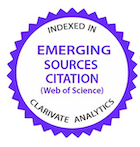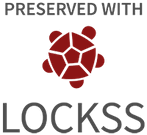Uso de ramas de batata-doce para produção de feno
DOI:
https://doi.org/10.1590/1809-6891v21e-53493Resumo
Ramas de batata-doce apresentam características satisfatórias para alimentação animal, porém não têm sido exploradas na forma de feno. Objetivou-se avaliar o uso de ramas de batata-doce para a produção de feno e a divergência genética em clones de batata-doce. Foram avaliados dez clones de batata-doce, conduzidos a campo em blocos ao acaso e cinco repetições. Foram determinados o teor de matéria seca, as produtividades de massa verde e massa seca (PMS), a relação folha e haste das ramas e a produção total e comercial de raízes (PRC). Obtidos os fenos, avaliaram-se as características MS, PB, FDN, FDA, lignina, amido, açúcares solúveis, macro e micronutrientes. Estimou-se a divergência genética entre os clones de batata-doce. O clone UFVJM-54 aliou alta PRC com maior PMS. Os fenos apresentaram teores de PB variando de 11,99 a 15,09%, FDN 47,22 a 55,55%, FDA 22,92 a 28%, e 6,87 a 13,72% de LIG. De forma geral, os teores de minerais nos fenos foram satisfatórios. Os clones foram separados em cinco grupos diferentes. As ramas de batata-doce podem ser utilizadas para a produção de feno. Os clones UFVJM-37, UFVJM-46 e UFVJM-54 são recomendados para cruzamentos com os demais genótipos.
Palavras-chave: Ipomoea batatas; alimentação animal; forragem; melhoramento genético.
Downloads
Referências
Monteiro AB, Massaroto JA, Gasparino CF, Silva RR, Gomes LAA, Maluf WR, Filho JCS. Silagens de
cultivares e clones de batata doce para alimentação animal visando sustentabilidade da produção
agrícola familiar. Revista Brasileira de Agroecologia. 2007; 2(2):978-981. Disponível em: http://revistas.
aba-agroecologia.org.br/index.php/cad/article/view/2697. Portuguese.
Andrade Júnior VC de, Viana DJS, Pinto NA, Ribeiro KG, Pereira RC, Neiva IP, Azevedo AM, Andrade PC
de R. Características produtivas e qualitativas de ramas e raízes de batata-doce. Horticultura Brasileira.
; 30(4):584–589. Disponível em: http://doi:10.1590/S0102-05362012000400004. Portuguese.
An LV; Lindberg BEF; Lindberg JE. Effect of harvesting interval and defoliation on yield and chemical
composition of leaves, stems and tubers of sweet potato (Ipomoea batatas L (Lam.)) plant parts. Field
Crops Research. 2003; 82:49–58. Disponível em: http://doi:10.1016/S0378-4290(03)00018-2. English.
Figueiredo JA, Andrade Júnior VC de, Pereira RC, Ribeiro KG, Viana DJS, Neiva IP. Avaliação de silagens
de ramas de batata-doce. Horticultura Brasileira. 2012; 30:708–712. Disponível em: http://doi:10.1590/
S0102-05362012000400024. Portuguese.
Andrade Júnior VC, Pereira RC, Dornas MF, Ribeiro KG, Valadares NR, Santos AA, Castro BM. Produção de
silagem, composição bromatológica e capacidade fermentativa de ramas de batata-doce emurchecidas.
Horticultura Brasileira. 2014; 32(1):91–97. Disponível em: http://doi:10.1590/S0102-05362014000100015.
Portuguese.
Pedrosa CE, Andrade Júnior VC, Pereira RC, Dornas MF, Azevedo AM, Ferreira MA. Yield and quality of
wilted sweet potato vines and its silages. Horticultura Brasileira. 2015; 33:283–9. Disponível em: http://
doi:10.1590/S0102-053620150000300002. Portuguese.
Azevedo AM, Andrade Júnior VC, Figueiredo JA, Pedrosa CE, Viana DJS, Lemos VT, Neiva IP. Divergência
genética e importância de caracteres em genótipos de batata-doce visando a produção de silagem.
Revista Brasileira de Ciências Agrárias. 2015; 10(3):479–484. Disponível em: http://doi:10.5039/agraria.
v10i3a5165. Portuguese.
Andrade Júnior VC, Gomes JA, Oliveira CM, Azevedo AM, Fernandes JS, Gomes LA, Maluf WR. Resistência
de clones de batata‑doce a Meloidogyne javanica. Horticultura Brasileira 2016; 34:130–136. Disponível
em: http://doi:10.1590/S0102-053620160000100020. Portuguese.
Filgueira FAR. Novo manual de olericultura: Agrotecnologia moderna na produção e comercialização
de hortaliças. Viçosa: Universidade Federal de Viçosa, 2008, 402p. Portuguese.
Detmann E, Souza MA, Valadares Filho SC, Queiroz AC, Berchielli TT, Saliba EOS, Cabral, LS, Pina DS,
Ladeira MM, Azevedo JAG (Ed.). Métodos para análise de alimentos. INCT-Ciência Animal, Visconde do Rio
Branco, Brasil. 2012, 214p. Portuguese.
McCready RM, Guggolz J, Silviera V, Owens HS. Determination of Starch and Amylose in Vegetables.
Analytical Chemistry 1950; 22:1156–1158. Disponível em: http://doi:10.1021/ac60045a016. English.
Malavolta E, Vitti GC, Oliveira SA. Avaliação do estado nutricional das plantas: princípios e aplicações.
ed. POTAFÓS, Piracicaba, Brasil. 1997, 319 p. Portuguese.
Cruz CD. GENES - a software package for analysis in experimental statistics and quantitative genetics.
Acta Scientiarum Agronomy. 2013; 35(3):271-276. Disponível em: http://doi:10.4025/actasciagron.
v35i3.21251. English.
Wilson JR. Environmental and nutritional factors affecting herbage quality. In: Hacker JB (Ed.)
Nutritional limits to animal production from pastures. Commonwealth Agricultural Bureaux, Farnham
Royal, England. 1982. p. 111-113. English.
IBGE. Instituto Brasileiro de Geografia e Estatística. Produção agrícola municipal 2016 [Internet].
[Acesso em: 25 de Jun. 2017] Disponível em https://www.ibge.gov.br/estatisticas-novoportal/
economicas/agricultura-e-pecuaria.html. Portuguese.
Neres MA, Ames JP. Novos aspectos relacionados à produção de feno no Brasil. Scientia Agraria
Paranaensis. 2015, 4:10-17. Disponível em http://dx.doi.org/10.18188/1983-1471/sap.v14n1p10-17.
Portuguese.
Mertens DR. Regulation of forage intake. In: Fahey Junior GC. (Ed.). Forage quality, evaluation and
utilization. American Society of Agronomy, Madison, USA. 1994. p.450-493. English.
Askar AR, Nassar MS, Badawy HS, Eid EY, Guada JA, Farid MFA. Recovered energy and efficiency of
digestion in sheep and goats fed Atriplex nummularia compared to alfalfa hay. Livestock Science. 2016;
:1–6. Disponível em: http://doi:10.1016/j.livsci.2016.10.009. English.
Padua FT de, Almeida JC de C, Silva TO da, Rocha NS, Nepomuceno D de D. Produção de matéria
seca e composição químico-bromatológica do feno de três leguminosas forrageiras tropicais em dois
sistemas de cultivo. Ciência Rural. 2006; 36:1253–1257. Disponível em: http://doi:10.1590/S0103-
Portuguese.
Van Soest, P. J. Nutritional ecology of the ruminant. Cornell University Press, Ithaca, USA. 1994, 446
p. English.
Simon JE, Lourenço Júnior JB, Ferreira GDG, Santos NFA, Nahum BS, Monteiro EMM. Consumo e
digestibilidade de silagem de sorgo como alternativa para alimentação suplementar de ruminantes na
Amazônia Oriental. Amazônia: Ciência & Desenvolvimento. 2009; 4(8):103-119. Disponível em: http://
ainfo.cnptia.embrapa.br/digital/bitstream/item/30486/1/ConsumoDigestibilida.pdf. Portuguese.
Norton BW. Differences between species in forage quality. In: Hacker JB (Ed.). Nutritional limits to
animal production from pastures. Commonwealth Agricultural Bureaux, Farnham Royal, England.1982.
p.89-110. English.
Medeiros SR, Marino CL. Carboidratos na nutrição de gado de corte. In: Medeiros SR, Gomes RC,
Bungenstab DJ. Nutrição de bovinos de corte: fundamentos e aplicações. Embrapa, Brasília, Brasil. 2015.
cap. 4, p. 45-62. Portuguese.
Faturi C, Ezequiel JMB, Fontes NA, Stiaque MG, Cruz e Silva OG. Fibra solúvel e amido como fontes de
carboidratos para terminação de novilhos em confinamento. Revista Brasileira de Zootecnia. 2006; 35:
-2117. Disponível em: http://dx.doi.org/10.1590/S1516-35982006000700031. Portuguese.
Mendonça Júnior AF, Braga AP, Rodrigues APDS, Sales LEM, Mesquita HC. Minerais: importância de
uso na dieta de ruminantes. ACSA - Agropecuária Científica no Semi-Árido. 2011; 07:01-13. Disponível
em: http://dx.doi.org/10.30969/acsa.v7i1.97. Portuguese.
Cruz CD, Regazzi AJ, Carneiro PCS. Modelos biométricos aplicados ao melhoramento genético. Viçosa:
Universidade Federal de Viçosa, 2012, 514p. Portuguese.
Publicado
Como Citar
Edição
Seção
Licença
Copyright (c) 2020 Ciência Animal Brasileira

Este trabalho está licenciado sob uma licença Creative Commons Attribution 4.0 International License.
Autores que publicam nesta revista concordam com os seguintes termos:
- Autores mantém os direitos autorais e concedem à revista o direito de primeira publicação, com o trabalho simultaneamente licenciado sob a Licença Creative Commons Attribution que permite o compartilhamento do trabalho com reconhecimento da autoria e publicação inicial nesta revista.
- Autores têm autorização para assumir contratos adicionais separadamente, para distribuição não-exclusiva da versão do trabalho publicada nesta revista (ex.: publicar em repositório institucional ou como capítulo de livro), com reconhecimento de autoria e publicação inicial nesta revista.
- Autores têm permissão e são estimulados a publicar e distribuir seu trabalho online (ex.: em repositórios institucionais ou na sua página pessoal) a qualquer ponto antes ou durante o processo editorial, já que isso pode gerar alterações produtivas, bem como aumentar o impacto e a citação do trabalho publicado (Veja O Efeito do Acesso Livre).






























